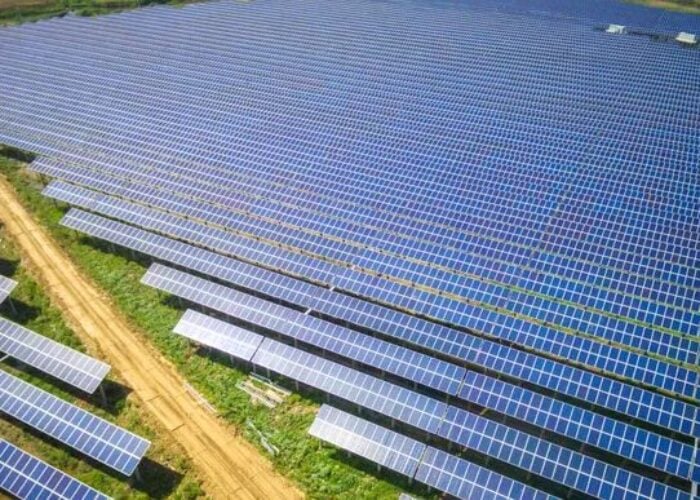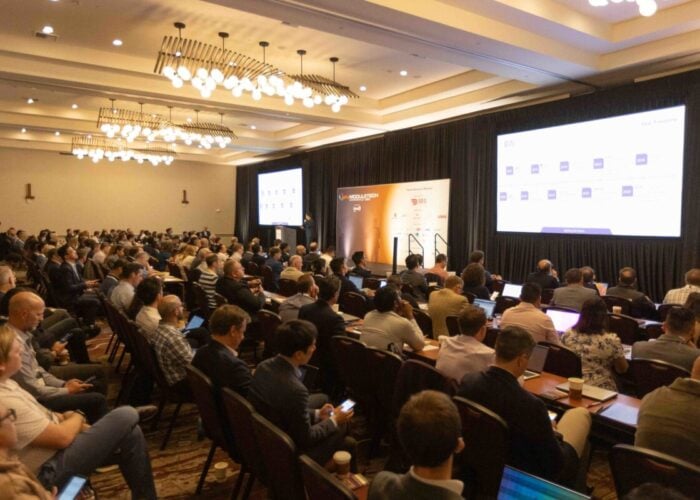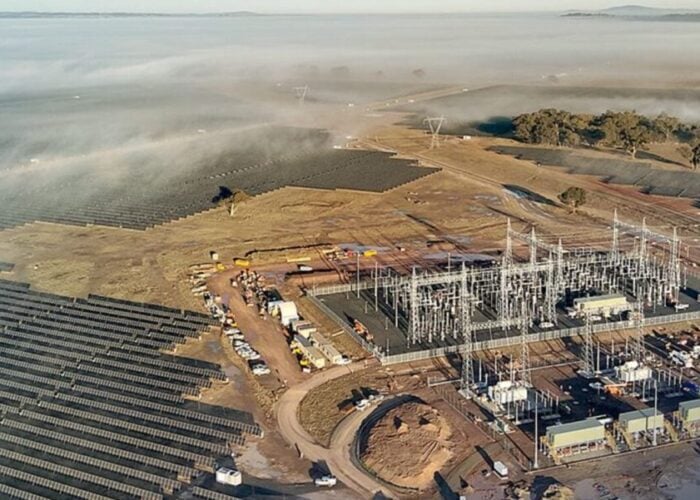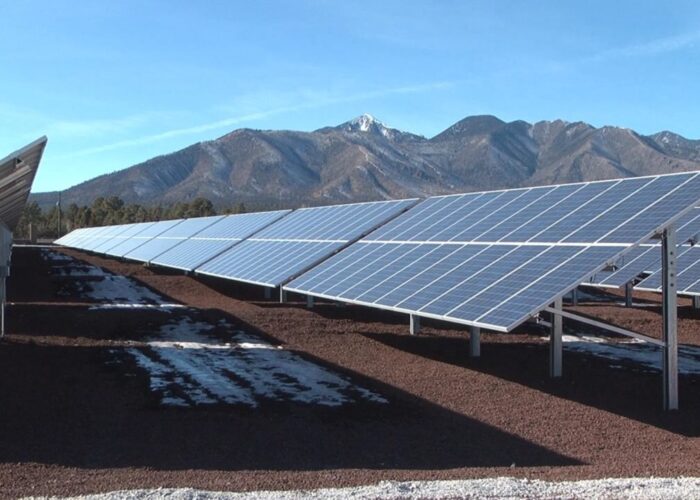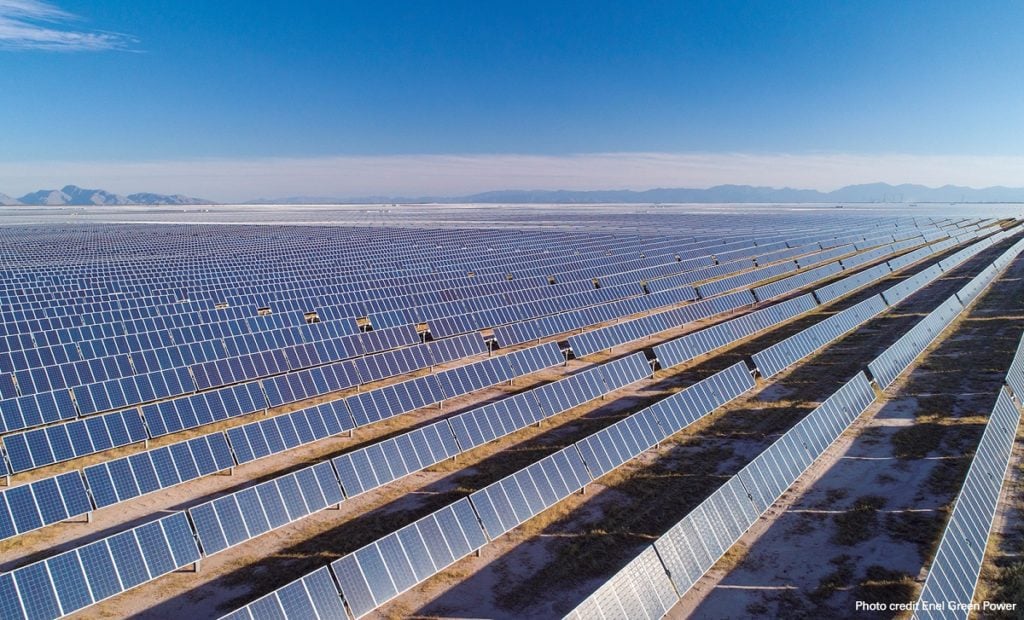
Favourable policy, large volumes of available land and a target of sourcing 35% of electricity from renewables by 2024 once made Mexico among the prime markets for solar development in Latin American, standing shoulder to shoulder with other prolific nations in the region such as Brazil and Chile.
These factors attracted major international energy firms such as Iberdrola, EDF Renewables and Enel Green Power – with Bruno Riga, head of Enel Green Power Mexico, describing the country’s solar and wind potential as “outstanding” due to its geographical location – among others, firmly cementing it as a target for international investors alongside homegrown solar from Mexican firms such as Zuma Energia and IEnova.
Unlock unlimited access for 12 whole months of distinctive global analysis
Photovoltaics International is now included.
- Regular insight and analysis of the industry’s biggest developments
- In-depth interviews with the industry’s leading figures
- Unlimited digital access to the PV Tech Power journal catalogue
- Unlimited digital access to the Photovoltaics International journal catalogue
- Access to more than 1,000 technical papers
- Discounts on Solar Media’s portfolio of events, in-person and virtual
But as June gave way to July in 2018, a speedbump emerged in the road, marking the start of what would be a turbulent period not only for solar PV, but for renewables as a whole. A new political maelstrom took the stage, garnering wide amounts of support to cinch what has been described as a landslide victory.
Taking office on 1 December 2018, Andrés Manuel López Obrador – often known by his initials AMLO – promised a “fourth transformation” in Mexico’s history in his victory speech, one which would be both peaceful and “radical”. This included policies to boost Mexico’s economy and increase social growth, as well as to improve the country’s education system.
Renewables, however, were rather further down on the agenda, with the left-wing politician bringing with him a decisive shift in energy policy that has led to a two and a half-year stretch of uncertainty ending in – at the time of writing – a battle in the courts.
How the tide turned for renewable policy
Recent years have seen an incredible amount of solar PV installed across the country. From smaller installations to the sprawling masses of panels making up assets such as Enel Green Power’s 828MW Villanueva solar park, the message has been clear that developers have been ready and willing to get infrastructure in the ground. This was in part aided by supportive policy coming out of the government of AMLO’s predecessor, Enrique Peña Nieto. The previous president enacted wide-sweeping changes to energy regulation that saw state oil firm Pemex’s monopoly come to an end and the introduction of auctions for clean energy.
The first of these auctions – the results of which were announced in March 2016 – saw seven wind and solar firms win electricity contracts and clean energy certificates (CEL). The second auction, the results of which were announced in October of the same year, saw 23 firms clinch contracts and CELs, with renewable projects worth US$4 billion and totalling 2,871MW of new generation capacity supported by the tender. Indeed, at the time of the auction, the average price – US$33.47/MWh – was described as being “among the lowest prices reached at the international level” by the Mexican energy ministry, marking the country as a hotspot for renewables development.
However, following AMLO’s election, a series of policy changes that would pause new connections and shunt renewables down the pecking order were enacted.
Firstly, the fourth of such renewable tenders was postponed in the same month AMLO took office, with it then pushed back once again in February – its supposed new date. At the time, the government gave the rationale that it would have been “irresponsible” to add more capacity when already contracted projects were yet to be built.
Months later, in January of 2020, AMLO confirmed that the government would not be scrapping renewable auctions, although some contracts that state run utility Comisión Federal de Electricidad (CFE) felt it had been “forced” to enter were to be revised, with AMLO taking particular umbrage with the fact “subsidies are being handed out to private [energy] operators”.
In April 2019 Manuel Bartlett, CEO of CFE, said it was an “aberration being forced to buy power from one’s competitors” and being told “we cannot generate our own power”.
French renewables developer Neoen’s deputy CEO, Romain Desrousseaux, says that privately-owned solar plants in Mexico “are seen as a threat, even if they can ultimately support CFE”. Giving the example of a Neoen solar plant in Mexico which is selling electricity at ~US$12.5/ MWh and creating green certificates at a price of ~US$6.5/MWh, which is well below grid parity, he says its Neoen’s belief that renewables can be “usefully incorporated into the country, creating jobs, diversifying the mix and enabling better prices”.
As it stands, there are no signs that auctions will resume. Marco Nieto- Vázquez, partner at Baker McKenzie Mexico, says that at this time, “we do not see any interest from decision makers to re-establish a new long-term renewable auction”.
“We consider that, if the current decision makers in Mexico do not align their nationalistic vision with a cost-efficient approach toward renewable energy principles, any measures taken to support the monopolistic operation in the power sector, will not be economically sustainable,” he adds.
This was not the only controversy to hit headlines over the past few years. May 2020 – the height of the COVID-19 pandemic – saw another move, this time from power market operator CENACE, which sought to block nationwide tests for new renewable plants in a bid to underpin system stability. These tests are required to switch on renewable plants, and the blocking of them left 44 solar and wind assets effectively stranded and unable to push the power they produce into the grid.
One such project was Neoen’s 375MWp El Llano solar installation. The asset reached full deployment at the start of 2020 and, pending the pre-operational tests due in July of that year, had already began to pump power into the grid. With the tests on hold, Neoen estimated it would suffer a monthly earnings shortfall of US$2 million.
Enter June 2020. CFE increased transmission rates for high voltage tariffs – applicable to power generators with legacy permits, so called because they secured contracts with the government prior to the 2013 energy reforms – by 469%, while medium voltage increased 428% and low voltage rates increased by over 800%. This resulted in legal battles between generators with legacy permits that provided low tariffs to incentivise investment in clean energy and the CFE. However, until the Supreme Court makes a final decision, the increases in transmission tariffs have been suspended.
“This uncertainty possibly affects private power generators who may seek to end power purchase agreements (PPAs) that no longer appear advantageous given the policy that placed limits on the number of permits issued for wind and solar projects and banned their construction in some parts of the country,” Gavin Rennie, EY global energy emerging markets leader and Latin America North power & utilities leader, says.
This comes alongside other reforms, including changes to power dispatch rules that would prioritise CFE’s portfolio of hydroelectric generators, followed by CFE’s other sources of power in the country. Only after those sources have been called upon would solar and wind generators owned by third parties be utilised. Despite outcry from the likes of the Global Solar Council, the reforms progressed regardless, passing Congress in February 2021 without alterations and being approved by the Senate in early March.
However, two days after the reforms became law, they were suspended following a court granting provisional injunctions against the law which were sought by a collection of renewables developers. Only a week later, a definitive suspension of the new electricity law was ordered.
This is not the end of the story for this specific law. AMLO has called on the Supreme Court to resolve the matter, although at the time of writing it is unknown when the case will be heard.
Uncertainty, risk and where the market heads next
The journey of energy policy through the courts, spanning many months and covering a variety of policies, with no end decision yet to be in sight, has created a much more uncertain environment for new solar developments. Desrousseaux says that the different reforms that are under discussion with the courts are creating uncertainty, which he labels as “the main challenge today” for developers.
Certainty can also impact on investor confidence, particularly as the increase in uncertainty can lead to additional risk. As Rennie describes it, while Mexico is a global market for investment in renewables, this investment will “ultimately go elsewhere if returns and certainty are more attractive”.
He says that the biggest challenge for investors looking at returns that cover multiple years is to have regulatory and policy certainty. This echoes Nieto- Vázquez, who says that any legal change that presumably affects the constitutional rights of private parties to maintain or develop infrastructure projects in a country “could raise doubts and influence an investor’s confidence”.
Despite this, there is not a simple yes or no answer to whether or not investors’ confidence has been dented. Nieto- Vázquez says he has a somewhat optimistic view on investment in the country, which comes from recent experience with Baker McKenzie’s clients. Whilst he says that policy changes are affecting “all the largescale and ongoing generation projects in different ways” and have “stalled or delayed future investments”, at a transactional level Baker McKenzie is currently helping its clients with the power purchase process, taking advantage of short-term price opportunities due to the competitiveness in the ‘inside the fence’ schemes – effectively behind the meter projects – as well as the “expected increase in the power demand in certain industries, both in the medium and long term”.
It is this behind the meter market where Nieto-Vázquez believes opportunities remain. He is not alone in this opinion, with Rennie agreeing opportunities remain in that sector, explaining that given the higher power costs in Mexico, businesses are driven to embrace a self-supply approach and power themselves with cheaper renewable energies. Walmart de México is one of many such companies to have taken this approach, having successfully completed the installation of a solar photovoltaic park that is to generate 20% of the energy consumed by its Aguascalientes store.
“There are still opportunities for insets – creating energy supplies directly for customers on their premises or nearby. These remain very attractive but [are] often smaller,” Rennie adds.
Analysis from the IEA in late 2020 examining global solar deployment out to 2025 found that the share of distributed applications in overall PV growth in the country was forecast to increase owing to net metering and net billing policies, while higher unsubsidised residential and commercial retail electricity prices would improve their economic attractiveness.
A solar asset manager operating in Mexico which preferred to remain unnamed says that the commercial and industrial and residential distributed generation markets are where it too sees more opportunity, with the development of utility-scale projects to “remain very challenging over the next few years”.
Whilst private PPAs remain the only alternative for utility scale projects after the cancellation of the auctions, the asset manager says that there are a number of “administrative burdens that are slowing down the implementation of private PPAs through qualified suppliers”. It adds that the regulatory uncertainty created by the current administration has changed its appetite in the sector in both the short and medium term.
However, PPAs in Mexico are becoming more popular according to Riga. The ability to provide cheap, efficient power while simultaneously boosting sustainability credentials is standing solar in good stead with commercial offtakers. More and more, Riga says, Mexican companies are realising that using renewables can help them better their relationships with customers and the communities where they operate and build a “better relationship grounded on transparency, sustainability and better business practices”.
“As it has happened in other parts of the world, companies are setting ambitious renewable energy targets to reduce emissions and improve their energy costs.”
Meanwhile, Enel Green Power’s ability to offer not only electricity generation but also risk management and in particular green certificates to companies with a +1MW electricity consumption per year is set to be one of its main growth drivers in the coming years in Mexico.
The IEA’s 2020 analysis also found that, with large consumers accounting for over 40% of electricity sales in Mexico, private renewable energy auctions and corporate PPAs are expected to drive annual additions of utility-scale solar PV during 2023-25. Overall, in its accelerated case, it expects an average of 3GW more solar capacity could be online during this time period, although this relies on more regulatory certainty for developers and rapid economic recovery for the distributed segment.
Embracing the multiple opportunities
In its main case, it expects 1.5GW of utility-scale solar to come online over 2021, 0.2GW of commercial and 0.1GW of residential. In 2022, it expects 0.9GW of utility-scale, another 0.2GW of commercial and another 0.1GW of residential.
While forecasts can attempt to put a quantitative figure on the future for solar in Mexico, the question remains at to whether these scenarios will come true and what could be done to enable the market to continue to flourish. In 2020, the country fell further down EY’s Renewable Energy Country Attractiveness Index (RECAI) from 25th to 33rd spot, with this being largely as a result of the policy uncertainty. However, that doesn’t mean it can’t become a more attractive market once again. Rennie says that many countries are creating durable, long lasting specific policies and regulatory frameworks to encourage renewables, continuing that Mexico has been as high as 6th in the RECAI “due to the scale of opportunity, as well as public auctions to stimulate the market – these are the areas that Mexico needs to work on”.
Indeed, it seems the viewpoint of the developers on the ground is that the recent uncertainty is simply a hurdle in the road and not a full blockade. Riga says that both Enel Green Power’s partners and nearly every company it has spoken to sees “multiple opportunities to continue driving the adoption of renewable energy, including solar”.
This is also similar to the opinion held by Neoen, with Desrousseaux stating the developer remains positive that in the long run, the government will “see the benefits of solar energy and will allow investment to resume”. Indeed, he finished to say that even with the current political uncertainty, with Mexico having “such strong fundamentals, the very long-term future looks bright”.



